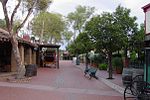Lowell Ranger Station
1934 establishments in ArizonaBuildings and structures in Pima County, ArizonaCivilian Conservation Corps in ArizonaCoronado National ForestGovernment buildings completed in 1934 ... and 5 more
Government buildings in ArizonaNational Register of Historic Places in Pima County, ArizonaPark buildings and structures on the National Register of Historic Places in ArizonaPueblo Revival architecture in ArizonaUnited States Forest Service ranger stations

The Lowell Ranger Station compound is in the Coronado National Forest of southern Arizona, United States. It is located in Pima County, near Tucson.
Excerpt from the Wikipedia article Lowell Ranger Station (License: CC BY-SA 3.0, Authors, Images).Lowell Ranger Station
Bear Canyon Trail #29,
Geographical coordinates (GPS) Address Nearby Places Show on map
Geographical coordinates (GPS)
| Latitude | Longitude |
|---|---|
| N 32.310833333333 ° | E -110.81777777778 ° |
Address
Bear Canyon Trail #29
85750
Arizona, United States
Open on Google Maps






